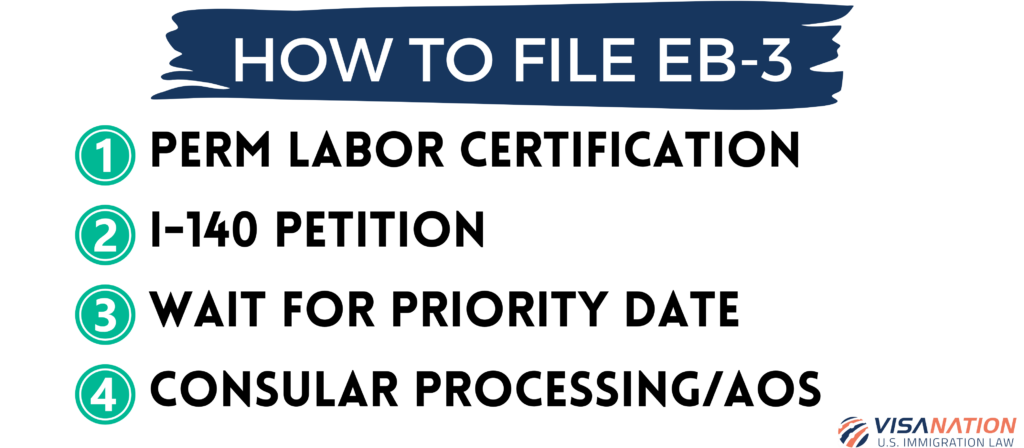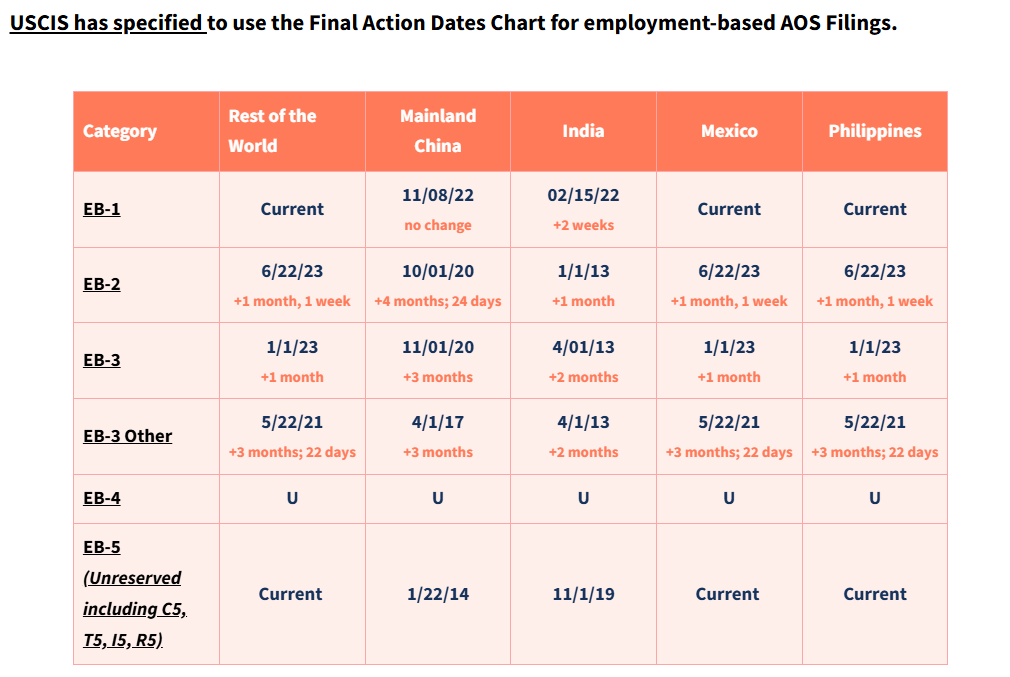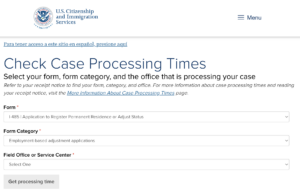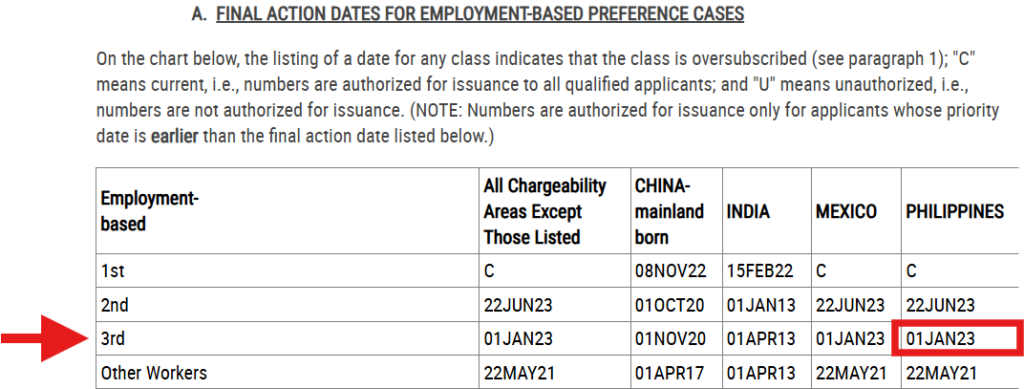Many people choose to work temporarily in the U.S. through nonimmigrant visas, while others want to make this country their permanent home. Immigrant visas, or green cards, allow foreign nationals to live and work in the U.S. for ten years at a time. One of the more common types of green cards that people seek is the EB-3 green card due to its relatively low requirements. However, this also makes it very popular, which can impact the time it takes to obtain one. Keep reading to find out what else goes into the EB-3 visa processing time to get one in 2025
EB-3 Requirements
To estimate how long it takes to get an EB-3, it’s important to outline the steps involved in preparing and petitioning for this type of green card.
The EB-3 is an employment-based immigrant visa that is on the third preference level. Because of this, the requirements are not as stringent as they are for the second and first preference levels (EB-1 and EB-2). There is no need to get a Master’s degree, prove exceptional abilities or achievements, or become a high-level executive or manager in a company.
To be considered eligible for an EB-3, you simply need to qualify for one of the following three categories:
- You are a foreign professional with a Bachelor’s degree. You must be able to prove that your occupation requires your specific degree.
- You are a skilled worker with at least two years of experience performing the tasks of your job.
- You are an unskilled worker in a job that does not have sufficient U.S. citizen workers available. This category requires your job to be permanent and not seasonal or temporary.
EB-3 Visa Process
To get this green card, you must go through the usual employment-based green card process.
- You first need to find an employer willing to sponsor you for your green card.
- Your employer then needs to acquire a PERM Labor Certification for you. This involves a recruitment process to ensure that no other qualified U.S. workers are available or willing to take your offered position.
- Once a PERM has been obtained, your employer can then file an I-140 Immigrant Petition for Alien Worker on your behalf.
- After the petition is filed, you will need to wait until your priority date is current in the Visa Bulletin. We will go into this step in more detail below.
- When your priority date is current, an immigrant visa number will be available, and you can apply to change your status by filing an I-485 Adjustment of Status form. Or, if you are outside the U.S., you can complete your DS-260 Online Immigrant Visa Application and go through NVC consular processing.
- Lastly, you will attend an interview at a USCIS office or U.S. consulate/embassy, depending on whether you are inside or outside the U.S.

How do EB-3 Priority Dates Work?
Your EB-3 priority date is the day that USCIS receives your I-140 petition. You will need to reference this date when checking the monthly visa bulletin released by the Department of State. Each year, there is a limit on how many immigrant visas are granted in each category. When the limit is exceeded, a backlog is created that can cause people from certain countries to wait from a few months to several years.
The visa bulletin provides the final action dates for the EB-3 Visa according to the applicant’s country of origin, so make sure to keep an eye on the date in your category. Here is an example:
Diana is a nurse from the Philippines who wants to work as a nurse in the U.S. She submitted her I-140 and recieved a priority date on June 15, 2023. She checks the most recent visa Bulliten, and checks the third row under A. final action dates for employment-based preference cases. Based on the final action date, she will likely have to wait at least 5 months before she will be able to apply for a change of status and obtain her green card. However, as we explain below, based on demand the Visa Bulliten occasionally does not progress.
Herein lies the problem with the EB-3 processing time for citizens of select countries (i.e., China and India). The final action dates can be backlogged for five to ten+ years. This EB-3 Visa Bulletin queue must be taken into account when considering the total EB-3 Processing times.
However, this is not always the case. Sometimes, the dates for many of the chargeability areas become or remain current, which can reduce the waiting times for the EB-3 green card.
Tip: Always be sure to check the most recent visa bulletin and consult with your immigration attorney to see how long you will have to wait before you can adjust your status or use consular processing.
To get a broader picture of how green cards are allocated, of the total 140,000 slots available for foreign workers, 28.6% (about 40,000) are designated for the EB-3 category. Additionally, no more than 7% of these EB-3 visas can go to foreign workers of any one particular country. For that reason, there is often a backlog due to the higher demand than the available visas.
EB-3 Wait time by Country – April 2025
The final action date in the Visa Bulletin provides an estimated waiting time and is based on your green card category and your home country. This date fluctuates based on how many people from your home country have petitioned for the EB-3 Visa.
If green cards are still available, the final action date will likely move closer to your priority date. But what if not enough green cards are available?
If that’s the case, you will not see any movement from that final action date. If the limit has been exceeded, you might see the date retrogress or move backward from your priority date. In the April 2025 Visa Bulletin, you will see that the Final Action date varies for each country:
- India: April 1st, 2013
- China: November 1st, 2020
- All other countries: January 1st, 2023
Discuss with your attorney about the most up-to-date information regarding the EB-3 wait time for your country. In some cases, porting may be a better option for you.

What is the Overall EB-3 Processing Time?
So the real question is: How long will it take to get my EB-3 green card?
To answer this, we need to break down each step of the EB-3 process:
1. PERM Labor Certification Processing Time: 6 – 12 Months
The PERM Labor Certification Process can take as little as 6 months and as long as 12 months after the ETA-9089 application is filed. This does not include the 30 days of recruitment required and the 30 days that need to pass after the end of the recruitment before applying. Here is the breakdown:
- On average, the DOL would typically provide the Prevailing Wage Determination within 3 months, but as of October 2023, the DOL is currently taking upwards of 6 months to approve.
- The advertisement and recruitment process usually takes at least 2 months.
- After submitting the request for the labor certification, it usually takes 6 to 8 months for the DOL to come to a decision.
NOTE: If your employer is audited, it could extend the processing time up to a year and a half.
2. I-140 Processing Time: 4-6 Months or 15 Days
According to USCIS data, the I-140 petition takes about 7.6 months to process without premium processing. However, if the USCIS sees that your priority date will not be current for some time, your petition may be pushed back to a date that is closer to your priority date and may take closer to 12 months to process. If your employer uses premium processing, the I-140 will be processed and receive a decision within 15 calendar days.
The I-140 premium processing fee is currently $2,805
3. Wait Time for Priority Date: Varies Widely
The wait time for your priority date varies depending on your country of origin. However, for most countries, there is a wait time of 2 years. It will also depend on whether you are going to adjust your status in the U.S. or use consular processing outside the U.S. Each of these two routes has its own processing times and requirements.
Though consular processing may be the faster option in some situations, it carries the risk of administrative processing, which may increase the overall wait time. However, adjustment of status also has the possibility of delays. We recommend you work closely with an immigration attorney to help you choose the best route for your case.
4. I-485 Petition for Status Adjustment: 6.9 Months (USCIS data)
According to USCIS data (FY 2025), the processing time for I-485 employment-based adjustment of status applications is 6.9 months. Unfortunately, there is no way to expedite this processing time. Sometimes, it may also take longer depending on the service center in charge of your case. To get the most accurate sense of your I-485 processing time, please use the USCIS processing time tool.
Enter your specific form into the fields and your field office/service center processing your case, then click “Get Processing Time.”

Overall, for applicants from countries other than India, China, Mexico, and the Philippines, you can expect your EB-3 processing time to be between 2-11 years.
Don’t hesitate to contact your immigration attorney to learn if there is a way to shorten this time.
Adjustment of Status vs Consular Processing
Once your priority date is current and your I-140 is approved, you can go through one of two routes to get your green card:
Adjustment of Status
The first is through adjustment of status. This is only available for those who have a nonimmigrant status to adjust in the first place. You must be currently in the U.S. under a nonimmigrant or temporary visa, such as an H-1B, L-1, or E-2 visa. If this is the case, then you will simply need to file an I-485 with the USCIS and wait for the form to be processed.
Consular Processing
On the other hand, those who are not in the U.S. under a nonimmigrant status must go through NVC consular processing. After your I-140 is processed, your case will be forwarded to the Department of State (NVC). The NVC process involves:
- Paying processing fees
- Submitting the DS-260 form
- Uploading documents to an online portal
- NVC will review your uploaded documents
- Medical examination with a panel physician authorized by the U.S. Department of State
- An interview with a U.S. consulate or embassy in your home country.
It may take between 3 to 6 months for processing to be completed, but this time depends on the backlog at the embassy. Once you’re at the embassy, a consular officer will interview you to determine if your case is legitimate. He or she may ask you basic questions (such as who your employer is) or more specific questions (such as what your plans are in the U.S.) or a combination of both. The goal is to ensure that you are who you say you are and that your intent to live permanently in the U.S. under EB-3 status is legitimate.
Consular processing is the only option available to those who live outside the United States. In some cases, it can be the less expensive option. In terms of timeline vs adjustment of status, the consular process can be faster if the consulate is efficient and has available interview slots. Therefore, in terms of time, consular processing may be a better option in terms of overall EB-3 processing time.
Can Premium Processing Help?
Fortunately, the USCIS offers an optional service to expedite the process of all visa petitions that use the I-129 or I-140 forms. By paying an additional fee of $2,805, you can shorten the processing time of your petition to 15 calendar days. However, this does not expedite any other step in the EB-3 process.
It is also important to note that, if your priority date will not be current for some time, premium processing may not help, as you cannot adjust your status until your priority date is current, even if your I-140 is approved. Also, premium processing will not increase your chances of having your petition approved. Speak with your immigration attorney to learn if this option is right for your case.
Benefits of The EB-3 Visa
There are several benefits to having an EB-3 visa, including:
- Permanent residency in the U.S.
- Not necessary to obtain an EAD to work
- Less rigorous requirements than other permanent resident visas, such as EB-1 or EB-2
- Spouse and children may accompany you to the U.S
- Can change job positions or employers after a few years
What Goes into Consular Processing
If you are going to process your EB-3 green card outside the U.S., you will need to complete the following steps:
Complete the DS-261 Application
Once the USCIS has approved the I-140 filed by your employer, your case will be forwarded to the National Visa Center (NVC), which will assign a case number for your petition. When your priority date meets the most recent final action date, you will be notified to complete the DS-261.
The DS-261 is an online form that requires you to provide your personal information to help give the Department of State (DOS) details on the best channels of communication throughout the application process. After successfully completing the DS-261, you will need to print the confirmation page of the form, as that will be included in your supporting documents.
Complete the Immigration Medical Exam
Before your interview date, you will need to schedule and complete certain medical examinations and vaccinations. The results will be part of the criteria to determine your admissibility to the U.S.
How To Prepare Your EB-3 Green Card Supporting Documents
After the approval of your DS-261 by the NVC, you will need to submit the following EB-3 supporting documents for consular processing:
- Your passport(s) must be valid for at least six months beyond your intended date of arrival in the U.S.
- Two photographs, both of which must meet these requirements
- The approved PERM Labor Certification
- The employment letter from your prospective U.S. employer
- The approved I-140 petition
- The DS-261 confirmation page
- Any relevant credentials and academic records
- Your resume or CV
- Criminal records
- Medical documents
NOTE: Depending on the embassy and the individual’s case, the supporting documents may vary from what has been listed here. You will need to check with your attorney to be sure that you have the required documents for your case.
Attend Your Visa Interview
Upon receiving and reviewing your supporting documents, the NVC will schedule a visa interview for you at the consulate or embassy. If all goes well at the interview and your visa is approved, the NVC will send you your passport containing your immigrant visa and a sealed package.
These are all you need to travel to the U.S. Do not open the sealed package–it should only be opened by an immigration officer when you get to a U.S. port of entry. Once you have been admitted to the U.S., your employment-based green card (I-551) will be mailed to you.
What are the EB-3 Green Card Processing Fees?
The EB-3 green card costs will depend on certain factors, such as your location and whether you are using the regular method or premium processing service. Fees to be paid by the employer and employee are as follows:
Employers costs
- I-140 fee: $715 (employer)
- Asylum Program Fee (employer)
- Regular Petitioner: $600
- Small Employer or self-petitioner: $300
- Nonprofit: $0
- I-907 fee for premium processing: $2,805 – optional (employer)
Employee costs
- I-485 Status Adjustment fee: $1,440 (employee, only paid by those living in the U.S already)
- Consular Processing fee: $345 (employee, only paid by those living outside the U.S.)
- Medical appointment fee does not apply.
- USCIS Immigrant Fee:$235
Other fees may include the costs of advertising for the PERM Labor recruitment process by the employer. You may also want to factor in the cost of hiring an immigration lawyer, which is optional and negotiable, but strongly recommended.
Frequently asked questions
What is the eb3 green card processing time for indian?
EB-3 Applicants from India face long processing times, with a minimum wait of 11 years for final action dates on the Visa Bulletin.
Can E3 visa holders bring dependents?
Yes, E-3 Visa holders can bring their families. Just like every other employment-based green card, if your EB-3 visa is approved, your immediate relatives (spouse and unmarried children under the age of 21) can join you in the U.S.
If your EB-3 visa was approved under the skilled and professional category, your spouse can apply for the E34 visa, and your children can apply for the E35 visa.
For those classified in the unskilled EB-3 worker category, your spouse and children can apply for the EW-4 and EW-5 visas, respectively.
If the application is approved, your spouse can apply for an Employment Authorization Document (EAD) to be able to work lawfully in the U.S. while the permanent residency application is being processed.
Can We Change from EB3 to EB2 after I-140 Approval?
Because the wait times can be so long for certain priority dates, there are situations where an applicant gains the education or requirements necessary to upgrade his or her green card. If you originally applied for an EB-3 and gained your Master’s degree while you waited, you could be eligible to reapply for an EB-2, which is sometimes referred to as ‘porting’ (although, it isn’t so much porting as it is starting over from square one for the I-140 process). You may also be able to retain your original priority date.
However, you would first need to get a different job that clearly requires your new education. This can be achieved either through your current employer or with a new one. Here is an example:
Purna is an electrical engineer from India with his bachelor’s degree in that field. He applies for the EB-3, but his priority date will not be current for almost ten years. So, he continues his education and gets his Master’s degree. To re-apply for an EB-2 under this new qualification, Purna needs to find a job either through a promotion or with a different employer that makes use of his new Master’s degree.
If you are eligible to port your green card and you have found a suitable job, the employer that is sponsoring you for the new green card will need to obtain a new PERM Labor Certification for you before filing another I-140. Because this is a delicate process, always work closely with your immigration attorney in cases such as these.
Recommended read: EB-3 to EB-2 Porting
 Shilpa Malik
Shilpa Malik  Boris Ignachkov
Boris Ignachkov 


